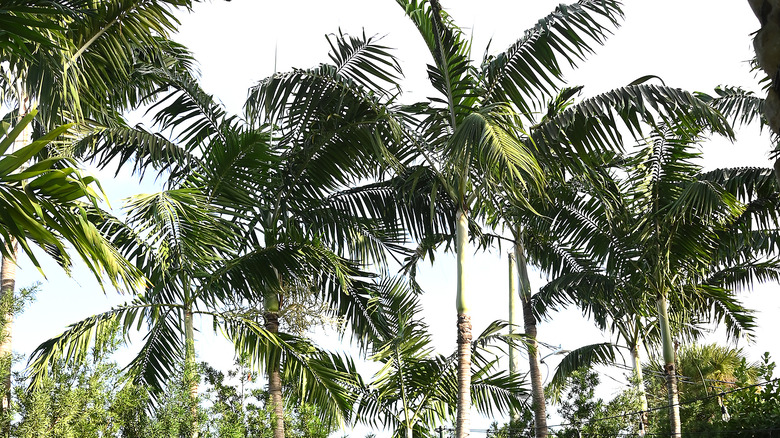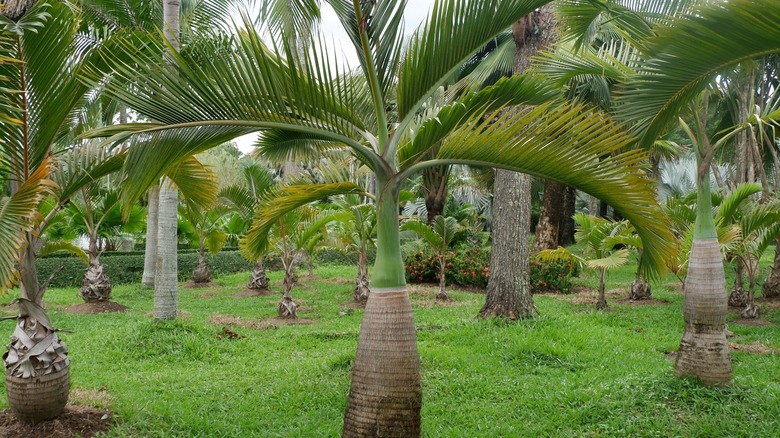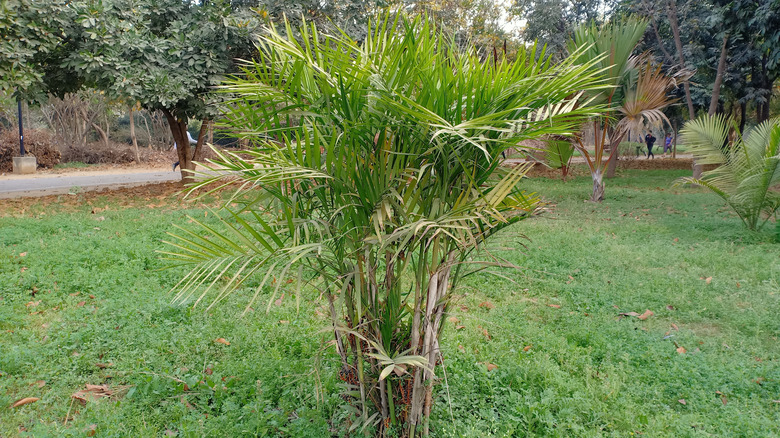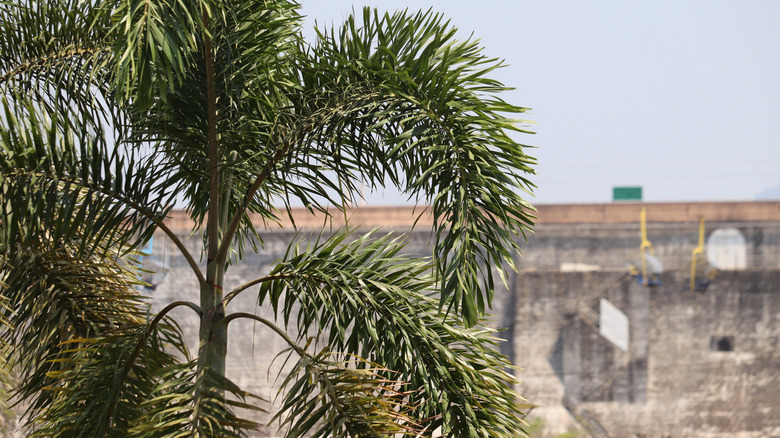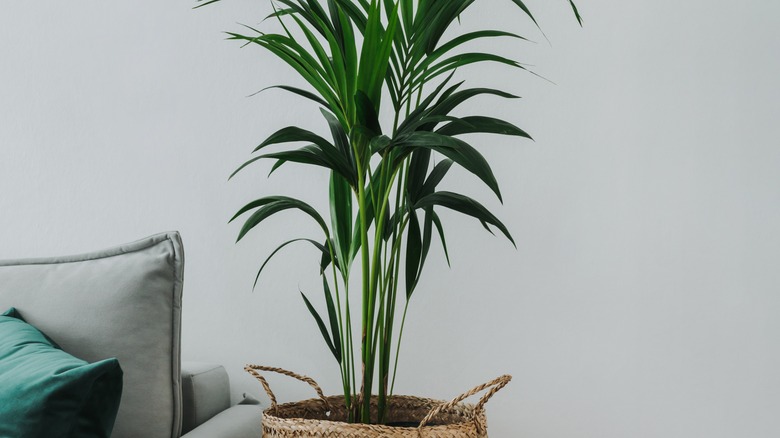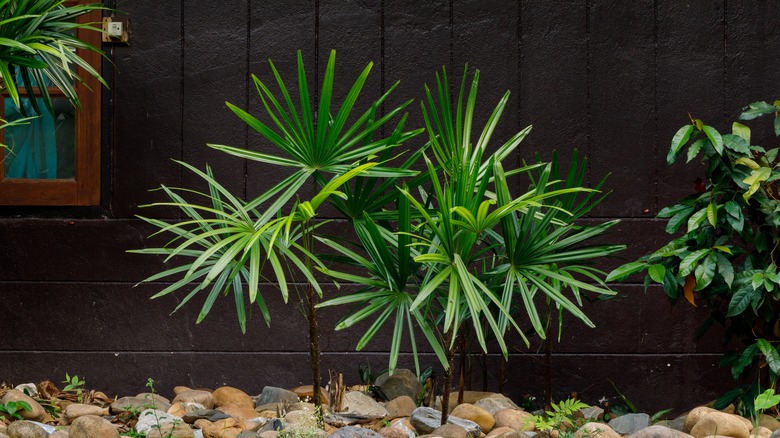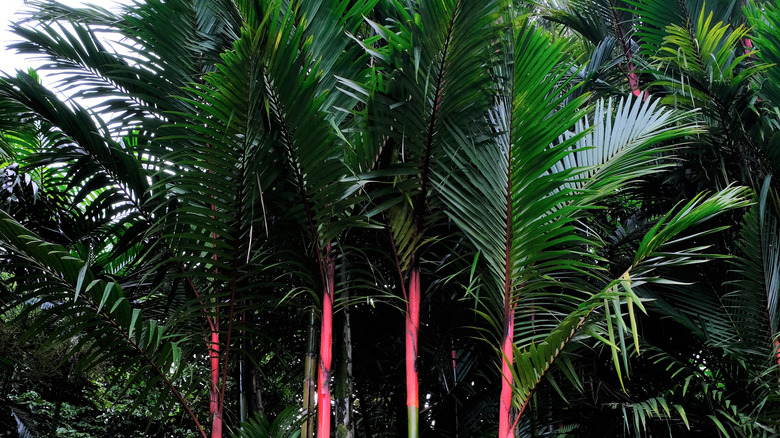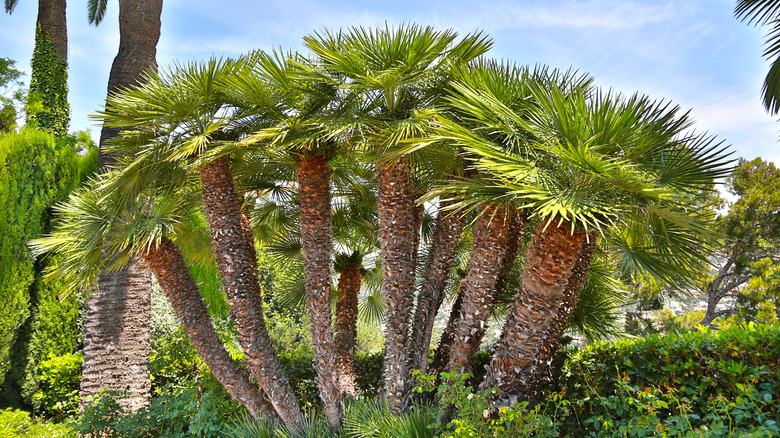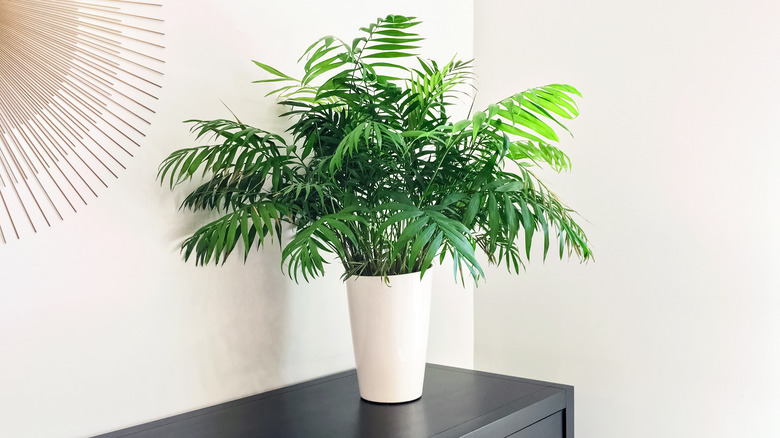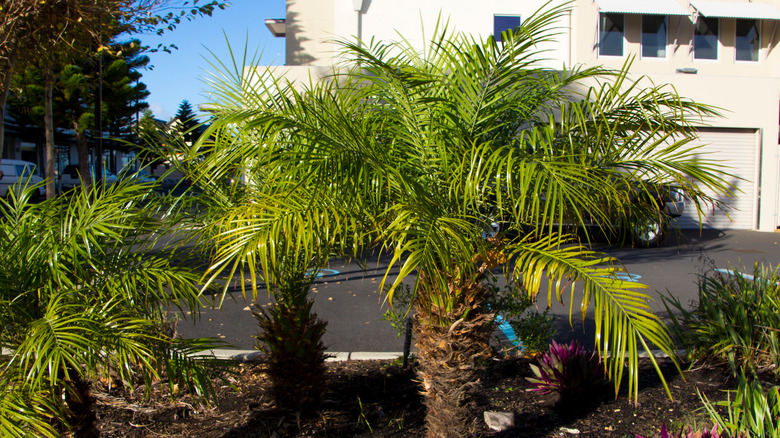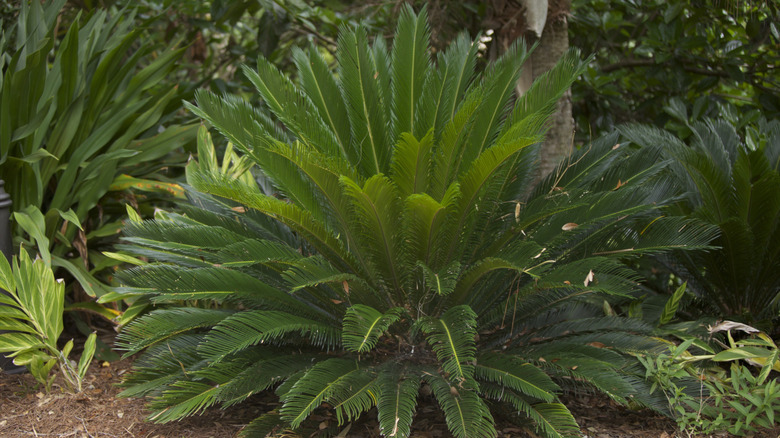What Are The Different Kinds Of Palm Trees?
Palm trees are members of the Arecaceae family in the plant kingdom. Primarily found in tropical and subtropical environments, approximately 4,000 species of these evergreen, perennial trees exist around the world (via La Palmeraie gb). Palms are further classified as monocots due to their economic value to humans via the edible food substance contained in their seeds.
Although they are commonly labeled as trees, palms vary greatly from hardwood, deciduous trees. For example, these plants do not produce secondary growth, and their stems (trunks) do not increase in diameter along their length. This trait gives many palm trees the tall, skinny appearance that we associate with images of tropical beach locations.
To enhance the beauty of your garden, plant palm trees In a warm-climate landscape, Choose from among numerous palm species for tall growth that towers above the other trees and plants. Alternatively, you might select a dense, low-growing palm that offers a shrub-like appearance. For plant lovers who live in colder climates, several types of palm plants grow well indoors. They can provide a gentle, tropical presence in an indoor living space.
Bottle palm tree
With its distinctive, bottle-shaped trunk and the limited number of fronds, the bottle palm tree (Hyophorbe lagenicaulis) is a standout in the garden (via Fast Growing Trees). Alternatively, it lends ambiance to your home when used as a potted, indoor plant. With its slow-growing nature and small root ball, the bottle palm is an ideal plant for container gardening, either indoors or on a patio. Indoors, your bottle palm tree will require weekly misting to maintain a moist atmosphere. Water the plant when the top two inches of soil feel dry to the touch.
All About Palm Trees recommends planting a bottle palm tree outdoors in USDA zones 10a and 11. Ensure that the soil provides ample drainage and that the roots stay moist but not wet. These trees thrive in shade, partial shade, and full sun. In a sunny spot, the bottle palm will require more water. The bottle palm tree grows up to approximately 10-to-20 feet in height, and the foliage may thicken to an impressive 10-to-15-foot diameter. This tree produces lovely white flowers in the summer as well as fruits resembling berries that turn black as they ripen.
Cat palm
According to the South Florida Plant Guide, the cat palm (Chamaedorea cataractarum) is a small palm tree that typically grows to no more than eight feet tall. It produces dense, feathery, evergreen fronds. If you want to create a tropical foliage screen for backyard privacy, the cat palm may be an excellent landscaping choice. Unlike other palm trees, this palm does not grow a central trunk. Instead, the cat palm sends up vertical stems lined with soft fronds that sway in the breeze.
Grow cat palms in the warmer regions of USDA zone 9b as well as in zone 10. They thrive in shady locations and function well as an understory for taller trees. Alternatively, cat palms form graceful silhouettes when they're displayed in containers on porches or patios. Water these plants regularly, but don't let their roots stay wet. It's a good idea to place peat moss in a well-drained hole when you're planting a cat palm. Additionally, you'll make the cat palm happy by fertilizing it once per season in spring, summer, and fall.
Coconut palm
The coconut palm (Cocos nucifera) stands out as an icon of tropical paradise locations all over the world. According to the University of Florida, it's the source of coconuts and copra, the substance from which coconut oil is extracted. The tree is native to coastal beaches in tropical climates, and its slender trunk can reach towering heights of up to 100 feet. Additionally, the leaf stalks may grow to 18 feet long with myriad leaflets branching off bilaterally to create an expanse of four feet wide.
After about four to six years of growth, the coconut palm begins to produce both male and female flowers in various shades of yellow. The fruit that follows is the hard-shell coconut. This large nut grows to around 15 inches in length and 12 inches in diameter. Inside the hairy shell, you'll find the white, edible meat called copra. Additionally, the coconut's interior space contains a watery fluid called coconut milk. These trees thrive in well-drained, sandy soil and full sun. They tolerate temperatures that reach over 100 degrees Fahrenheit, but they do not survive freezing temperatures.
Florida royal palm
Growing to massive proportions, the Florida royal palm trees (Roystonea regia) sway in the breezes of South Florida. According to Wild South Florida, it is recognized as the national tree of Cuba, and the royal palm is sometimes called the Cuban royal palm. When these palm trees are planted in rows, they create a regal presence in formal landscape designs. The slender trunks may reach up to 120 feet in height, and the top of a royal palm may spread out over 25 feet in diameter. Gardenia notes that a single frond from a royal palm tree may grow to be 10-to-15 feet long and weigh up to 50 pounds.
The royal palm is native to Mexico, South Florida, Central America, and the Caribbean islands. It grows in USDA zones 10 and 11 and displays a brawny resistance to hurricanes. This tree likes hot temperatures and full sun, but it will tolerate partial shade. It thrives in moist, well-drained soil. However, the mature royal palm is also drought-tolerant. Due to its predisposition to developing nutrient deficiencies, it's a good idea to fertilize your Florida royal palm tree on a regular schedule. Apply a fertilizer that provides boron, manganese, and potassium.
Foxtail palm
The foxtail palm (Wodyetia bifurcata) sends out 8-to-10 feathery fronds that move gently in the breeze atop a narrow, gray trunk (via CTAHR, University of Hawaii). Each frond consists of numerous, slender leaflets lining a central shaft that may grow up to 10 feet long. The tree's common name derives from the dense growth of these leaflets, creating a bushy appearance that is reminiscent of a fox's tail.
Plant Informer notes that the foxtail palm is native to Australia. These trees grow up to 30 feet tall indoors, and they can reach an outdoor height of 50 feet. A potting soil containing both vermiculite and peat moss provides an optimal growing medium for a potted foxtail palm. Gardeners may grow potted foxtail palms indoors until they touch the ceiling and then transplant them to sunny spots in the outdoor landscape. Fertilize the foxtail palm approximately once a month and water it twice a week during spring and summer. Stop fertilizing and back off on watering during the cooler months.
Kentia palm
Bring the beauty of the tropics into your home with a potted Kentia palm (Howea forsteriana). House Plants Expert observes that it's easy to grow indoors and does not require strong sunlight. The Kentia palm is native to Australia, and it produces lush foliage with dense, green leaves. When this palm is grown indoors, it may reach a height of 10 feet. Pet parents need not worry about keeping this houseplant in the living space. If dogs and cats chew on the leaves, the Kentia palm is non-toxic.
Plantz advises that you water the Kentia palm in a manner that moistens the entire root ball. Then, don't water it again until the soil feels dry. Apply a complete-nutrition, houseplant fertilizer once every three months. Don't be surprised when the aging leaves of the Kentia palm turn yellow and then brown. Simply prune and remove these parts to preserve the plant's lush, green appearance. Keep the Kentia palm in top-notch condition by occasionally cleaning its leaves with a soft, damp cloth. If the plant is infested with scale, you'll see tiny brown spots on the undersides of the leaves. Wipe these spots off with the cloth while you're in the process of cleaning the plant.
Lady palm tree
Lady palm trees (Rhapis excelsa) produce lush, green growth when they're planted outdoors in USDA zones 10 and 11. They may grow to a height of 6 to 15 feet (via Gardenia). These palms spread by rhizomes to create dense, shrub-like masses of evergreen foliage in the garden. The lady palm thrives in well-drained, loamy soil and tolerates both partial sun and shady conditions. If you're looking for a tropical plant to fill in an open space beneath tall trees, the lady palm is a viable choice.
Lady palms remain small when they're grown as potted, indoor plants. African violet potting mix is the best soil medium for growing a lady palm indoors (via Smart Garden & Home). Place your indoor lady palm in a location where it gets indirect sunlight. Water the plant liberally, then let the soil dry out completely before you water it again.
Lipstick palm (red sealing wax palm)
Take one look at the bright red crown shaft of the lipstick palm (Cyrtostachys renda), and you'll understand the origin of its name. In fact, this plant is sometimes called the red sealing wax palm (via All About Palm Trees). It grows outdoors in USDA zones 10b to 11, and it thrives in sunny locations as well as in partial shade. The stems of the lipstick palm grow in bunches that may become 10-to-20 feet tall. The plant produces greenish flowers as well as inedible fruits that turn black as they ripen.
If you live in a location north of USDA zone 10b, you might include a lipstick palm in your collection of houseplants. According to Greg, you should place the plant in direct sunlight, preferably in close proximity to a south-facing window. Establish a consistent watering schedule that gives the soil a drying-out interval between waterings. After a year, it's time to transplant the lipstick palm to a slightly larger pot. On the other hand, if the plant doubles in size before the year is up, you should give it a new, bigger container. Regular potting soil contains sufficient nutrients to promote growth and good health for your lipstick palm.
Mediterranean fan palm
If you're looking for a palm tree that will tolerate frost, the Mediterranean fan palm (Chamaerops humilis) may be a good choice for your location. It's more hardy than most palm trees. According to Texas A&M's AgriLife Extension, this palm tree will survive when the temperature dips as low as 10 degrees Fahrenheit. On top of that, the tough Mediterranean fan palm will tolerate drought conditions as well as multiple types of soil.
Monrovia notes that the Mediterranean fan palm is suited for USDA zones 8 through 11. The vertical stems of this palm emerge in clusters, and the plants may reach 10 to 15 feet in both height and width. This palm thrives in full to partial sunlight. The distinctive, fan-shaped leaves grow to approximately 2 feet wide. Each leaf exhibits numerous divisions, resulting in a series of stiff, pointed, finger-like sections. If you want to create a hedge or privacy screen in the landscape, the Mediterranean fan palm is a perfect choice.
Parlor palm
Grown as a houseplant, the parlor palm (Chamaedorea elegans) evokes the ambience of grand old hotels and fine Victorian homes. If it's treated well, this indoor palm can top 10 feet when it's full-grown (via The Sill). Due to its growth pattern, the parlor palm resembles bamboo. It sends up numerous vertical stems that form clusters. The fronds consist of soft, dark green leaflets attached to the stalks. Overall, the parlor palm produces a lush screen of evergreen foliage. Flowers emerge from the base of the plant, followed by inedible fruit. The parlor palm will be happy if you water it every 7 to 14 days and maintain the humidity at a level that's comfortable for humans.
According to Bloomscape, the parlor palm grows slowly and requires minimal fuss. Additionally, this houseplant is non-toxic for your furry friends, and it functions as an air purifier in your home. Place the parlor palm in front of a window covered with blinds or a sheer curtain, and the plant will thrive in the filtered sunlight. If necessary, the parlor palm can adapt to low light conditions.
Pygmy date palm
The slow-growing pygmy date palm (Phoenix roebelenii) produces lush, feathery, evergreen fronds. According to the South Florida Plant Guide, it grows to a maximum height of around 12 feet. Each pygmy date palm tree features a single trunk. Gardeners frequently plant several of these palm trees together to make a strong statement in the landscape. The fronds of this palm tree arch out and droop downward to produce a lovely weeping effect. Due to their pleasing shapes, pygmy date palms make excellent accent trees for entryways and planting beds to complement your home's architectural features.
The pygmy date palm will tolerate the moderately cold temperatures in USDA zone 9b. This palm tree requires minimal maintenance and grows in light conditions ranging from fun sun to partial shade. To keep your pygmy date palm healthy, apply palm fertilizer once every three months during the spring, summer, and fall seasons.
Sago palm
Displaying a short and uniquely textured trunk, the sago palm (Cycas revoluta) sends out its evergreen fronds in a symmetrical shape. According to the Planting Tree, it thrives without extensive maintenance whether it's planted outdoors or grown as a houseplant. Outdoors, the sago palm grows in USDA zones 8 through 10. This palm grows slowly and survives for many years. As they grow, the fronds extend outward, resulting in a shape that is approximately equal in height and width. A fully mature sago palm might measure up to 10 feet both tall and wide.
When grown as a houseplant, the sago palm needs plenty of indirect sunlight and ample space for its fronds to spread out (via Houseplants Expert). It grows slowly indoors and will reach approximately two feet in height. Plant this palm in a pot with drainage holes, and use a potting mix that is formulated to provide aeration. Keep the soil moist but not wet. When the top inch of soil begins to dry out, it's time to water the plant again. Pet parents should be aware that the leaves of the sago palm are poisonous and may be fatal when ingested by dogs and cats.
If you live in a warm, southern region, the palms of the Arecaceae family offer a plethora of options for outdoor plants and trees to perform numerous functions in the landscape. Whether you seek low-growing, bushy plants or stately, towering trees, there are palms to fill your landscaping needs. Many palms grow well in containers on porches and patios in warm weather and then adjust to indoor conditions when winter arrives. This family of plants offers numerous choices for indoor gardeners who live in regions with cold winters. Most houseplant palms require little fuss, and they live for years with a bit of care and maintenance.
